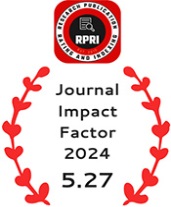The Kalachuris and Their Architectural Legacy in Dakshin Kosala
DOI:
https://doi.org/10.55544/ijrah.4.1.30Keywords:
Kalachuris, Dakshin Kosala, Ratanpur, Chhattisgarh, Shaktism, Mahamaya Temple, Architectural HeritageAbstract
The Kalachuri dynasty, a crucial force in the history of Central India, is best understood through the rise of its three major branches: Mahishmati, Tripuri, and Ratanpur. The latter, the Ratanpur Kalachuris, initially based in Tummana (modern-day Korba District, Chhattisgarh) before relocating to Ratanpur (Bilaspur District, Chhattisgarh), played a vital role in shaping the cultural, religious, and architectural heritage of Dakshin Kosala. Although the Ratanpur Kalachuris were initially subordinate to the Tripuri Kalachuris, their reign flourished under the leadership of King Jajalladeva I during the early 12th century, marking the zenith of their political and cultural influence. This dynasty continued its rule until Pratapamalla (1188–1217 AD), with an interlude before the division of the Kalachuri state into two branches: Ratanpur and Raipur, in the 15th century. Central to their legacy is a rich architectural heritage, particularly evident in the temples, forts, and water reservoirs that dot Dakshin Kosala. These structures embody a fusion of regional and cultural elements, showcasing the Kalachuris' support for Shaktism, their promotion of local artistic traditions, and their influence on religious practices. The Mahamaya Temple in Ratanpur, dedicated to the family deity of the Kalachuris, exemplifies this synthesis and remains a key cultural and religious symbol in the region. The architectural output of the Kalachuris is more than just a testament to their religious devotion; it provides invaluable insights into the religious and cultural life of Dakshin Kosala and continues to influence local practices today.
Downloads
References
Rawat, Brijesh. (2020). A symbolic Worship of Smarta Lingas in South Kosala. International Journal for Innovative in Multidisciplinary Field. Gujrat. Pp. 112 - 115.
Rowland, Benjamin. (1953). The Art and Architecture of Indian. London: Penguin Books. Pp. 116 - 130.
Sahu, N.K. (1971). A Survey on the History of South Kosala. N. A. H. O. Vol. I.
Shastri, J.L. (1950). Siva Purana - English Translation (Part – 1 to 4). Delhi: Moti Lal
Banarasidas Publishers Pvt. Ltd. Pp. 111 - 117.
Stadtner, D.M. (1980). A Sixth Century A.D. Temple from Kosala, A.A.A. Vol. XXXIII. Pp. 38 - 48.
Stietencron, Heinrich Von. (2003). Hindu Myth, Hindu History: Religion, Art and Politics. Delhi: Permanent Black. Pp. 107 - 112.
Verma, K.P. (2010). Chhattisgarh Ki Sthaptya Kala (Sarguja Jile Ke Vises Sandarbh me). Raipur. Pp. 139 – 157
Acharya, P.K. (Ed.). (1993). An Encyclopaedia of Hindu Architecture, Manasara - Vol.VII. New Delhi: Munshiram Manoharlal Publishers Pvt Ltd. Pp. 120-137.
Bajpai. K.D. (1946). Mahakosala in Ancient Literature. Proceedings of the Indian History Congress. Pp. 53-56.
Basu Chatterjee, Paramita. (2009-2010). Patronage Issues in Tripuri & Ratanpur Under the Kalachuris – A Brief Discussion Based on Epigraphic Sources. Proceedings of the Indian History Congress - Vol. 70. Pp. 118-129.
Bhattacharya, T.P. (1986). A Study on Vastu-vidya or Canons of Indian Architecture. Columbia: South Asia Books. Pp. 125-139.
Chakravarty, K.K. & Sharma, R.K. (Ed.). Misra, O.P. (Associate Ed.). (1991). Art of the Kalachuris. Bhopal: Commissioner Archaeology and Museums Madhya Pradesh, Bhopal. Pp. 17-29.
Chaturvedi, Rakesh. (Ed.). Yadav, S.S. & Bajpai, S.K. (Associate Ed.). (2008). KOSALA. Government of Chhattisgarh (Raipur): Journal of the Directorate of Culture & Archaeology (Year I). Pp. 137-142.
Dutt, Tr. M.N. (1957). Agni Purana. Ed. by M.C. Apte. A.S.S. Pune.
Dwivedi, Dr. Seema. (2014). Culture and Tradition of Chhattisgarh. International Journal of Humanities and Social Science Invention - Vol. 3. Pp. 13 - 15.
Havell. E. V. (1911). Hand book of Indian Art. London: John Murray Albemarle Street, W. Longhurst, A. H. (1909 - 1910). Ancient Brick Temples in Central Provinces. A. S. I. A. R. Pp. 11 - 17.
Minj, Rajeev John. (2001). Characteristic Features of Temple Architecture of the Late Kalachuris of Chhattisgarh. Chhattisgarh: Journal of Pt. Ravishankar Shukla University (Part – A. Vol. 8 – 15). Pp. 55 - 59.
Mirashi, V.V. (Ed.). (1995). Corpus Inscriptionum Indicarum (Vol. IV). Inscriptions of the Kalachuri - Chedi Era (Part II). India: Department of Archaeology. Pp. 410 - 412.
Mirashi, R.N. (1989). Sculptures of Dahala and Daksina Kosala and Their Background. Delhi: Agam Kala Prakashan. Pp. 198 - 205.
Nigam, L.S. (2000). Riddle of Indian Iconography. Delhi: Sharada Publishing House.
Nigam, L.S. (1995). Art Tradition of Daksina Kosala (CHHATTISGARH). Chhattisgarh: Journal of Pt. Ravishankar Shukla University (Part - A. Vol. 8 - 15). Pp. 1 - 8.
Pandey, L.P. (1950). The Name of Maha Kosala and Its Use. J. K. H. R. S. (Vol. I). Pp. 38 -43.
Downloads
Published
How to Cite
Issue
Section
License

This work is licensed under a Creative Commons Attribution-NonCommercial-NoDerivatives 4.0 International License.




















